MA611: Auditing Theory and Practice - Risk of Misstatement Report
VerifiedAdded on 2022/11/28
|13
|3870
|117
Report
AI Summary
This report provides an in-depth analysis of auditing theory and practice, with a specific focus on identifying material misstatements in financial reporting. The study employs analytical procedures, including simple comparisons and ratio analysis, to evaluate the financial statements of Vicinity Centr...
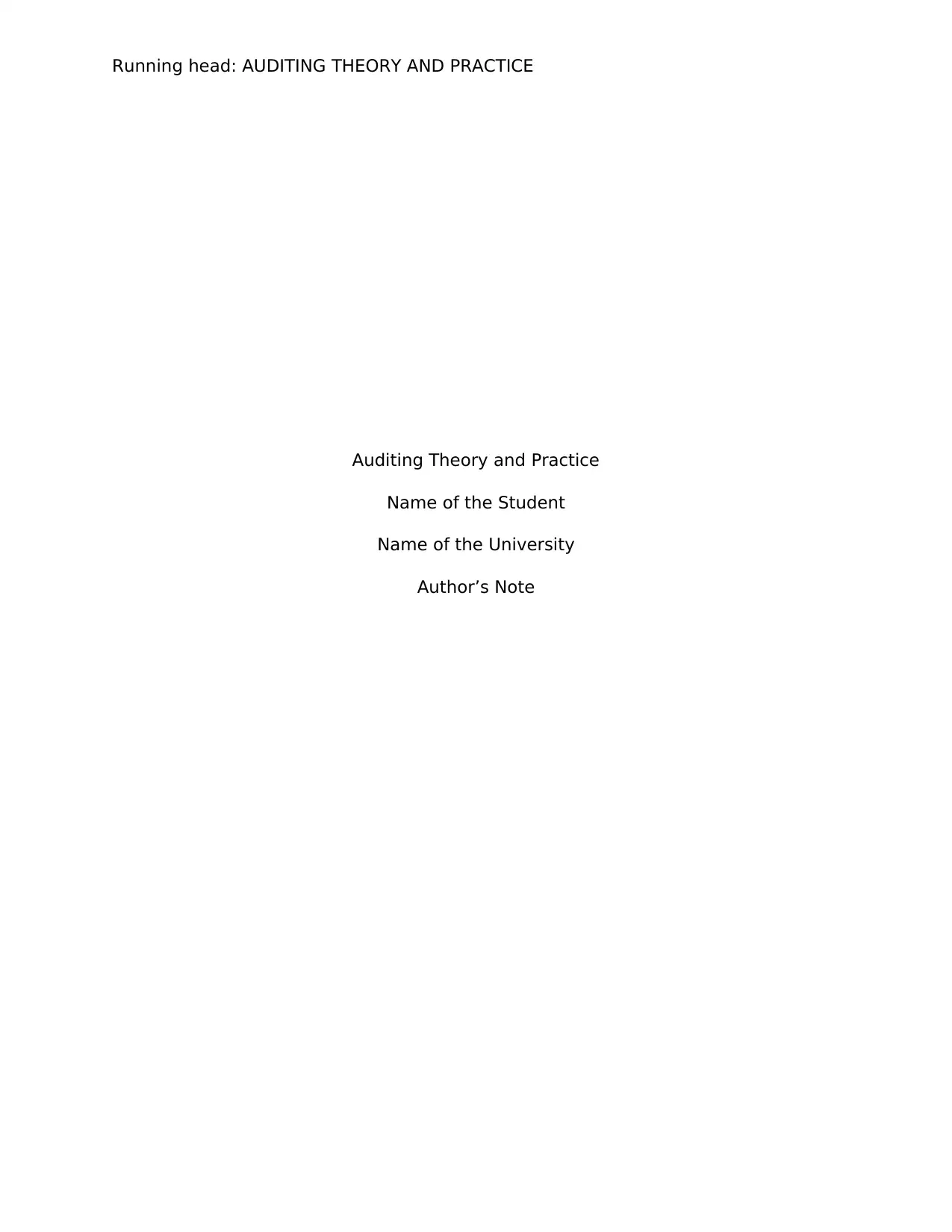
Running head: AUDITING THEORY AND PRACTICE
Auditing Theory and Practice
Name of the Student
Name of the University
Author’s Note
Auditing Theory and Practice
Name of the Student
Name of the University
Author’s Note
Paraphrase This Document
Need a fresh take? Get an instant paraphrase of this document with our AI Paraphraser
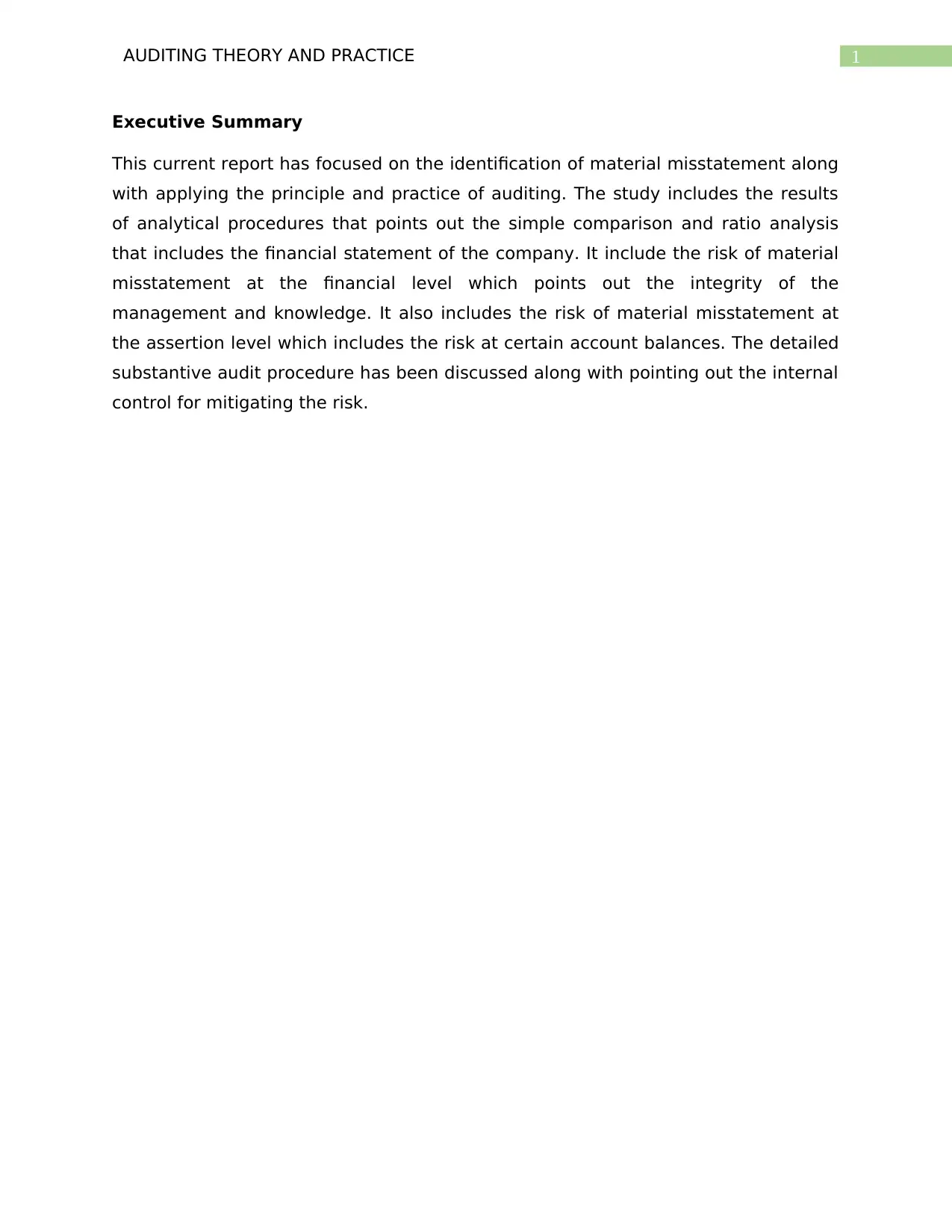
1AUDITING THEORY AND PRACTICE
Executive Summary
This current report has focused on the identification of material misstatement along
with applying the principle and practice of auditing. The study includes the results
of analytical procedures that points out the simple comparison and ratio analysis
that includes the financial statement of the company. It include the risk of material
misstatement at the financial level which points out the integrity of the
management and knowledge. It also includes the risk of material misstatement at
the assertion level which includes the risk at certain account balances. The detailed
substantive audit procedure has been discussed along with pointing out the internal
control for mitigating the risk.
Executive Summary
This current report has focused on the identification of material misstatement along
with applying the principle and practice of auditing. The study includes the results
of analytical procedures that points out the simple comparison and ratio analysis
that includes the financial statement of the company. It include the risk of material
misstatement at the financial level which points out the integrity of the
management and knowledge. It also includes the risk of material misstatement at
the assertion level which includes the risk at certain account balances. The detailed
substantive audit procedure has been discussed along with pointing out the internal
control for mitigating the risk.

2AUDITING THEORY AND PRACTICE
Table of Contents
Introduction................................................................................................................ 3
Results of Analytical Procedures................................................................................3
Simple comparisons................................................................................................ 3
Ratio analysis.......................................................................................................... 4
Risk of Material Misstatement at Financial Report level.............................................5
Integrity of management........................................................................................ 5
Management experience, knowledge and changes during the period....................5
Unusual pressure on management.........................................................................6
Nature of entity’s business..................................................................................... 6
Factors affecting the industry in which the entity operates....................................6
Risk of Material Misstatement at Assertion level........................................................7
Conclusion.................................................................................................................. 8
References................................................................................................................. 9
Table of Contents
Introduction................................................................................................................ 3
Results of Analytical Procedures................................................................................3
Simple comparisons................................................................................................ 3
Ratio analysis.......................................................................................................... 4
Risk of Material Misstatement at Financial Report level.............................................5
Integrity of management........................................................................................ 5
Management experience, knowledge and changes during the period....................5
Unusual pressure on management.........................................................................6
Nature of entity’s business..................................................................................... 6
Factors affecting the industry in which the entity operates....................................6
Risk of Material Misstatement at Assertion level........................................................7
Conclusion.................................................................................................................. 8
References................................................................................................................. 9
⊘ This is a preview!⊘
Do you want full access?
Subscribe today to unlock all pages.

Trusted by 1+ million students worldwide
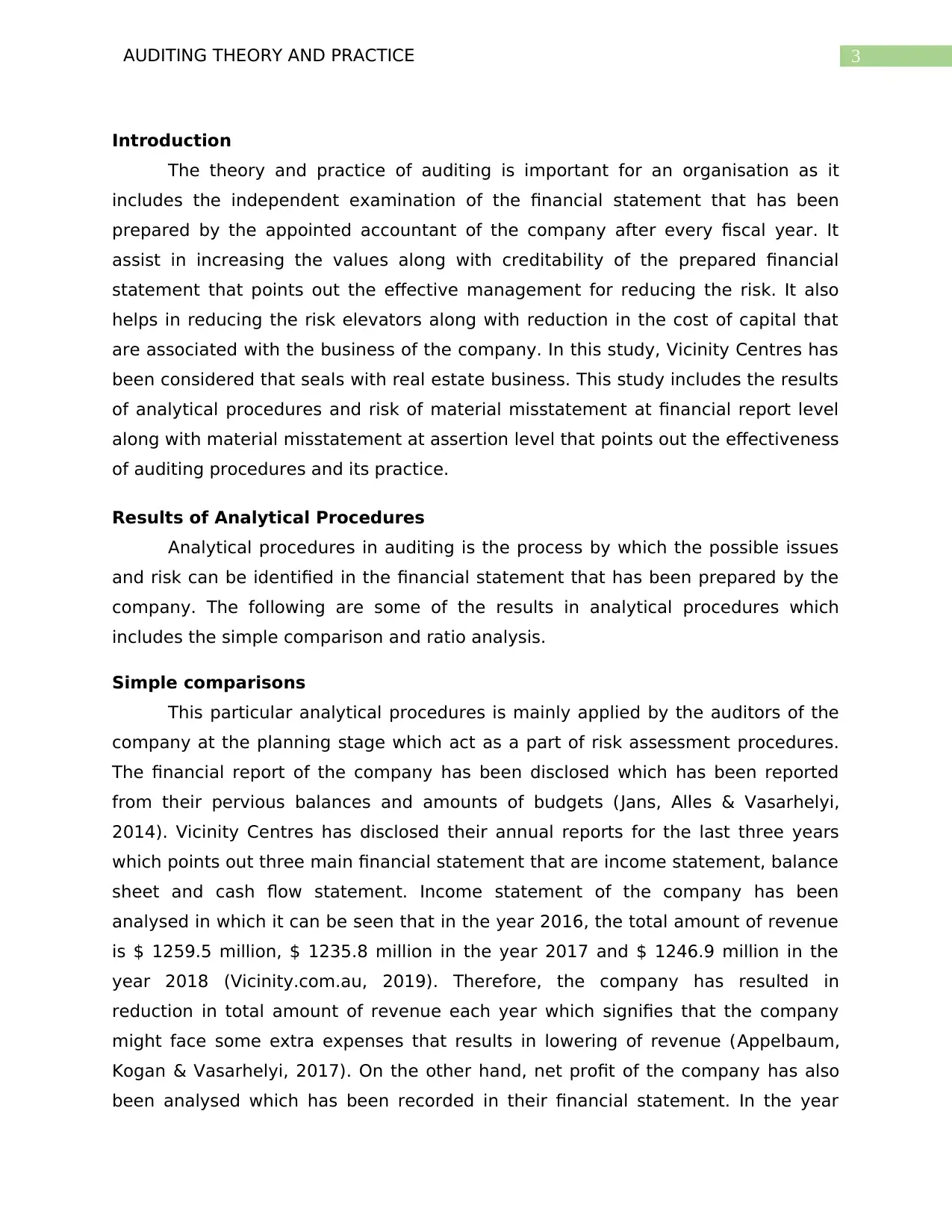
3AUDITING THEORY AND PRACTICE
Introduction
The theory and practice of auditing is important for an organisation as it
includes the independent examination of the financial statement that has been
prepared by the appointed accountant of the company after every fiscal year. It
assist in increasing the values along with creditability of the prepared financial
statement that points out the effective management for reducing the risk. It also
helps in reducing the risk elevators along with reduction in the cost of capital that
are associated with the business of the company. In this study, Vicinity Centres has
been considered that seals with real estate business. This study includes the results
of analytical procedures and risk of material misstatement at financial report level
along with material misstatement at assertion level that points out the effectiveness
of auditing procedures and its practice.
Results of Analytical Procedures
Analytical procedures in auditing is the process by which the possible issues
and risk can be identified in the financial statement that has been prepared by the
company. The following are some of the results in analytical procedures which
includes the simple comparison and ratio analysis.
Simple comparisons
This particular analytical procedures is mainly applied by the auditors of the
company at the planning stage which act as a part of risk assessment procedures.
The financial report of the company has been disclosed which has been reported
from their pervious balances and amounts of budgets (Jans, Alles & Vasarhelyi,
2014). Vicinity Centres has disclosed their annual reports for the last three years
which points out three main financial statement that are income statement, balance
sheet and cash flow statement. Income statement of the company has been
analysed in which it can be seen that in the year 2016, the total amount of revenue
is $ 1259.5 million, $ 1235.8 million in the year 2017 and $ 1246.9 million in the
year 2018 (Vicinity.com.au, 2019). Therefore, the company has resulted in
reduction in total amount of revenue each year which signifies that the company
might face some extra expenses that results in lowering of revenue (Appelbaum,
Kogan & Vasarhelyi, 2017). On the other hand, net profit of the company has also
been analysed which has been recorded in their financial statement. In the year
Introduction
The theory and practice of auditing is important for an organisation as it
includes the independent examination of the financial statement that has been
prepared by the appointed accountant of the company after every fiscal year. It
assist in increasing the values along with creditability of the prepared financial
statement that points out the effective management for reducing the risk. It also
helps in reducing the risk elevators along with reduction in the cost of capital that
are associated with the business of the company. In this study, Vicinity Centres has
been considered that seals with real estate business. This study includes the results
of analytical procedures and risk of material misstatement at financial report level
along with material misstatement at assertion level that points out the effectiveness
of auditing procedures and its practice.
Results of Analytical Procedures
Analytical procedures in auditing is the process by which the possible issues
and risk can be identified in the financial statement that has been prepared by the
company. The following are some of the results in analytical procedures which
includes the simple comparison and ratio analysis.
Simple comparisons
This particular analytical procedures is mainly applied by the auditors of the
company at the planning stage which act as a part of risk assessment procedures.
The financial report of the company has been disclosed which has been reported
from their pervious balances and amounts of budgets (Jans, Alles & Vasarhelyi,
2014). Vicinity Centres has disclosed their annual reports for the last three years
which points out three main financial statement that are income statement, balance
sheet and cash flow statement. Income statement of the company has been
analysed in which it can be seen that in the year 2016, the total amount of revenue
is $ 1259.5 million, $ 1235.8 million in the year 2017 and $ 1246.9 million in the
year 2018 (Vicinity.com.au, 2019). Therefore, the company has resulted in
reduction in total amount of revenue each year which signifies that the company
might face some extra expenses that results in lowering of revenue (Appelbaum,
Kogan & Vasarhelyi, 2017). On the other hand, net profit of the company has also
been analysed which has been recorded in their financial statement. In the year
Paraphrase This Document
Need a fresh take? Get an instant paraphrase of this document with our AI Paraphraser
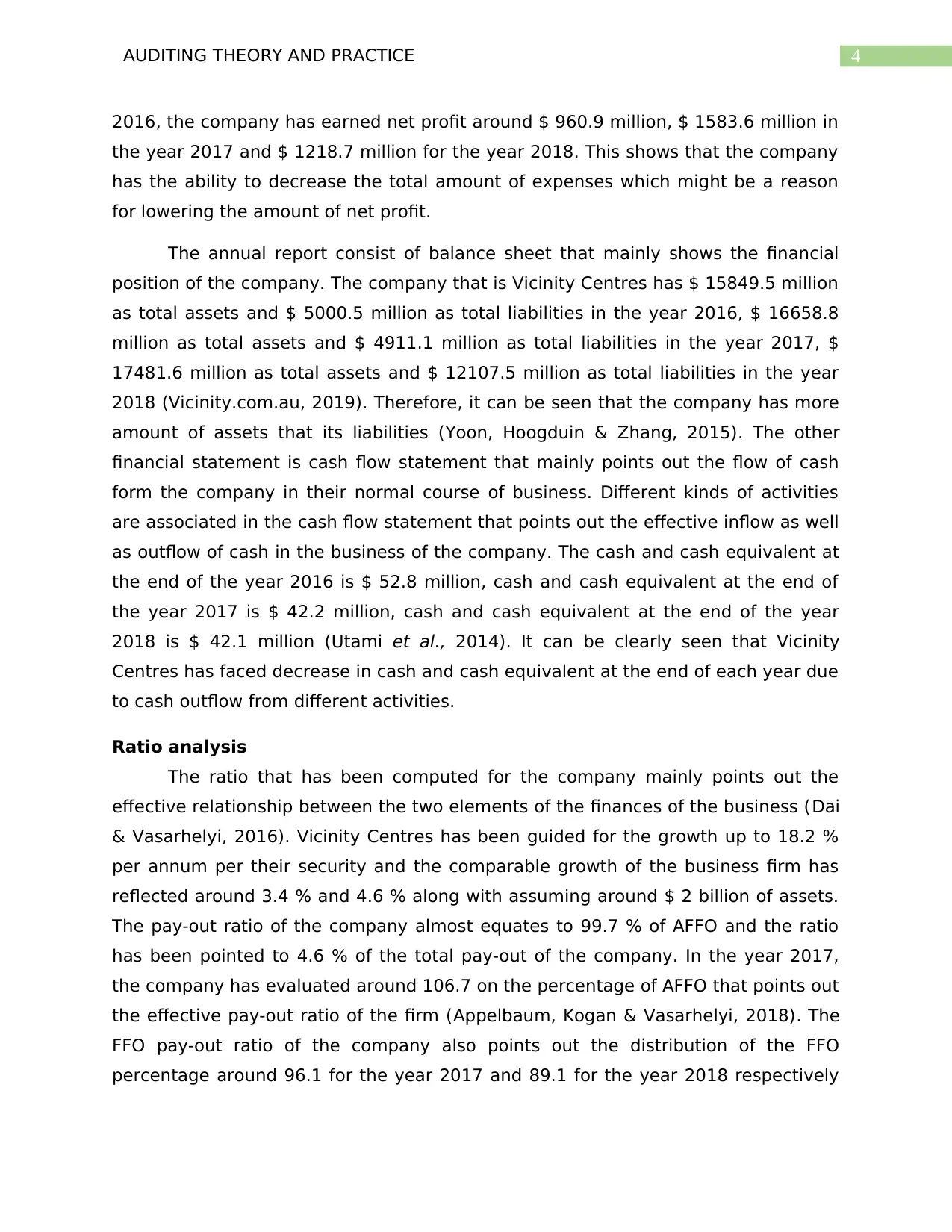
4AUDITING THEORY AND PRACTICE
2016, the company has earned net profit around $ 960.9 million, $ 1583.6 million in
the year 2017 and $ 1218.7 million for the year 2018. This shows that the company
has the ability to decrease the total amount of expenses which might be a reason
for lowering the amount of net profit.
The annual report consist of balance sheet that mainly shows the financial
position of the company. The company that is Vicinity Centres has $ 15849.5 million
as total assets and $ 5000.5 million as total liabilities in the year 2016, $ 16658.8
million as total assets and $ 4911.1 million as total liabilities in the year 2017, $
17481.6 million as total assets and $ 12107.5 million as total liabilities in the year
2018 (Vicinity.com.au, 2019). Therefore, it can be seen that the company has more
amount of assets that its liabilities (Yoon, Hoogduin & Zhang, 2015). The other
financial statement is cash flow statement that mainly points out the flow of cash
form the company in their normal course of business. Different kinds of activities
are associated in the cash flow statement that points out the effective inflow as well
as outflow of cash in the business of the company. The cash and cash equivalent at
the end of the year 2016 is $ 52.8 million, cash and cash equivalent at the end of
the year 2017 is $ 42.2 million, cash and cash equivalent at the end of the year
2018 is $ 42.1 million (Utami et al., 2014). It can be clearly seen that Vicinity
Centres has faced decrease in cash and cash equivalent at the end of each year due
to cash outflow from different activities.
Ratio analysis
The ratio that has been computed for the company mainly points out the
effective relationship between the two elements of the finances of the business (Dai
& Vasarhelyi, 2016). Vicinity Centres has been guided for the growth up to 18.2 %
per annum per their security and the comparable growth of the business firm has
reflected around 3.4 % and 4.6 % along with assuming around $ 2 billion of assets.
The pay-out ratio of the company almost equates to 99.7 % of AFFO and the ratio
has been pointed to 4.6 % of the total pay-out of the company. In the year 2017,
the company has evaluated around 106.7 on the percentage of AFFO that points out
the effective pay-out ratio of the firm (Appelbaum, Kogan & Vasarhelyi, 2018). The
FFO pay-out ratio of the company also points out the distribution of the FFO
percentage around 96.1 for the year 2017 and 89.1 for the year 2018 respectively
2016, the company has earned net profit around $ 960.9 million, $ 1583.6 million in
the year 2017 and $ 1218.7 million for the year 2018. This shows that the company
has the ability to decrease the total amount of expenses which might be a reason
for lowering the amount of net profit.
The annual report consist of balance sheet that mainly shows the financial
position of the company. The company that is Vicinity Centres has $ 15849.5 million
as total assets and $ 5000.5 million as total liabilities in the year 2016, $ 16658.8
million as total assets and $ 4911.1 million as total liabilities in the year 2017, $
17481.6 million as total assets and $ 12107.5 million as total liabilities in the year
2018 (Vicinity.com.au, 2019). Therefore, it can be seen that the company has more
amount of assets that its liabilities (Yoon, Hoogduin & Zhang, 2015). The other
financial statement is cash flow statement that mainly points out the flow of cash
form the company in their normal course of business. Different kinds of activities
are associated in the cash flow statement that points out the effective inflow as well
as outflow of cash in the business of the company. The cash and cash equivalent at
the end of the year 2016 is $ 52.8 million, cash and cash equivalent at the end of
the year 2017 is $ 42.2 million, cash and cash equivalent at the end of the year
2018 is $ 42.1 million (Utami et al., 2014). It can be clearly seen that Vicinity
Centres has faced decrease in cash and cash equivalent at the end of each year due
to cash outflow from different activities.
Ratio analysis
The ratio that has been computed for the company mainly points out the
effective relationship between the two elements of the finances of the business (Dai
& Vasarhelyi, 2016). Vicinity Centres has been guided for the growth up to 18.2 %
per annum per their security and the comparable growth of the business firm has
reflected around 3.4 % and 4.6 % along with assuming around $ 2 billion of assets.
The pay-out ratio of the company almost equates to 99.7 % of AFFO and the ratio
has been pointed to 4.6 % of the total pay-out of the company. In the year 2017,
the company has evaluated around 106.7 on the percentage of AFFO that points out
the effective pay-out ratio of the firm (Appelbaum, Kogan & Vasarhelyi, 2018). The
FFO pay-out ratio of the company also points out the distribution of the FFO
percentage around 96.1 for the year 2017 and 89.1 for the year 2018 respectively
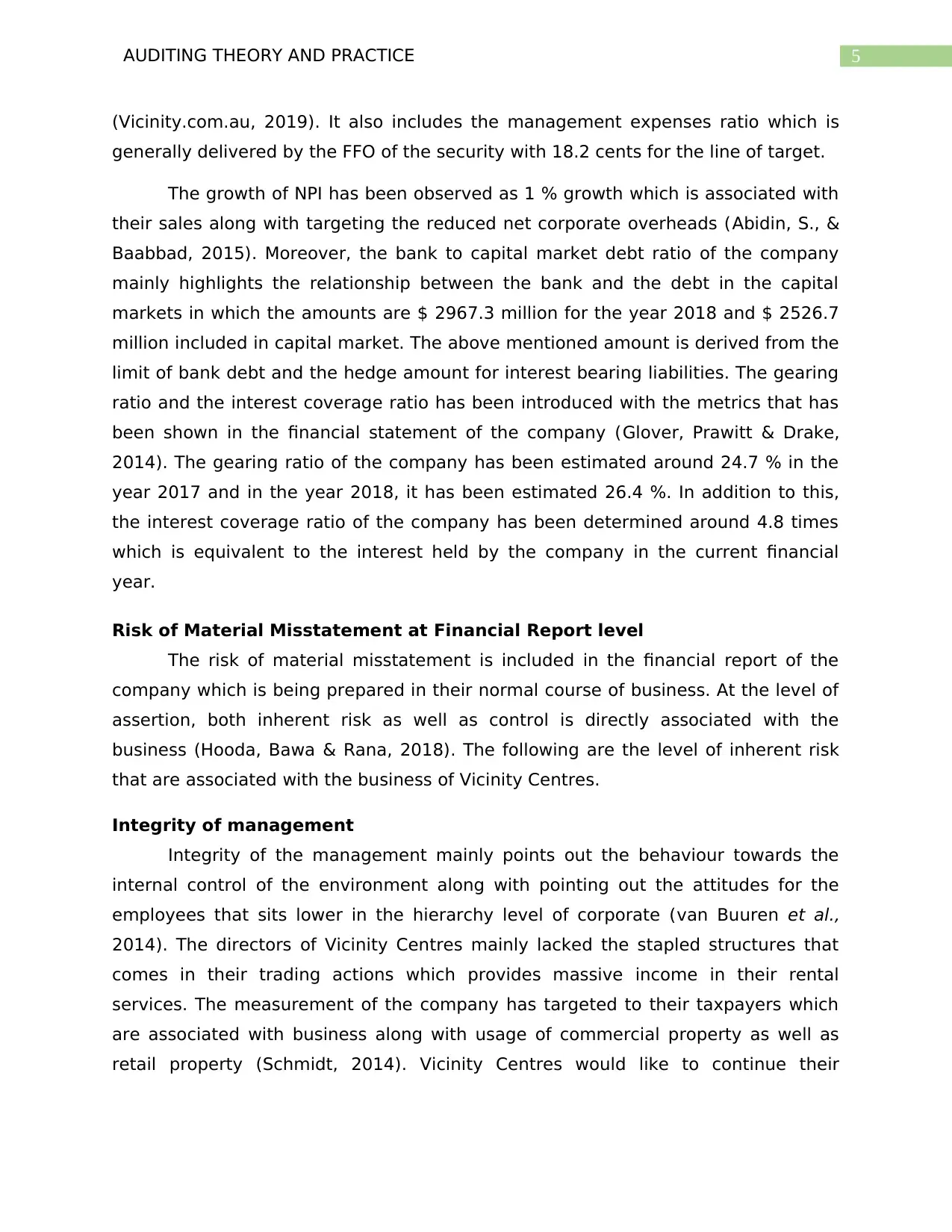
5AUDITING THEORY AND PRACTICE
(Vicinity.com.au, 2019). It also includes the management expenses ratio which is
generally delivered by the FFO of the security with 18.2 cents for the line of target.
The growth of NPI has been observed as 1 % growth which is associated with
their sales along with targeting the reduced net corporate overheads (Abidin, S., &
Baabbad, 2015). Moreover, the bank to capital market debt ratio of the company
mainly highlights the relationship between the bank and the debt in the capital
markets in which the amounts are $ 2967.3 million for the year 2018 and $ 2526.7
million included in capital market. The above mentioned amount is derived from the
limit of bank debt and the hedge amount for interest bearing liabilities. The gearing
ratio and the interest coverage ratio has been introduced with the metrics that has
been shown in the financial statement of the company (Glover, Prawitt & Drake,
2014). The gearing ratio of the company has been estimated around 24.7 % in the
year 2017 and in the year 2018, it has been estimated 26.4 %. In addition to this,
the interest coverage ratio of the company has been determined around 4.8 times
which is equivalent to the interest held by the company in the current financial
year.
Risk of Material Misstatement at Financial Report level
The risk of material misstatement is included in the financial report of the
company which is being prepared in their normal course of business. At the level of
assertion, both inherent risk as well as control is directly associated with the
business (Hooda, Bawa & Rana, 2018). The following are the level of inherent risk
that are associated with the business of Vicinity Centres.
Integrity of management
Integrity of the management mainly points out the behaviour towards the
internal control of the environment along with pointing out the attitudes for the
employees that sits lower in the hierarchy level of corporate (van Buuren et al.,
2014). The directors of Vicinity Centres mainly lacked the stapled structures that
comes in their trading actions which provides massive income in their rental
services. The measurement of the company has targeted to their taxpayers which
are associated with business along with usage of commercial property as well as
retail property (Schmidt, 2014). Vicinity Centres would like to continue their
(Vicinity.com.au, 2019). It also includes the management expenses ratio which is
generally delivered by the FFO of the security with 18.2 cents for the line of target.
The growth of NPI has been observed as 1 % growth which is associated with
their sales along with targeting the reduced net corporate overheads (Abidin, S., &
Baabbad, 2015). Moreover, the bank to capital market debt ratio of the company
mainly highlights the relationship between the bank and the debt in the capital
markets in which the amounts are $ 2967.3 million for the year 2018 and $ 2526.7
million included in capital market. The above mentioned amount is derived from the
limit of bank debt and the hedge amount for interest bearing liabilities. The gearing
ratio and the interest coverage ratio has been introduced with the metrics that has
been shown in the financial statement of the company (Glover, Prawitt & Drake,
2014). The gearing ratio of the company has been estimated around 24.7 % in the
year 2017 and in the year 2018, it has been estimated 26.4 %. In addition to this,
the interest coverage ratio of the company has been determined around 4.8 times
which is equivalent to the interest held by the company in the current financial
year.
Risk of Material Misstatement at Financial Report level
The risk of material misstatement is included in the financial report of the
company which is being prepared in their normal course of business. At the level of
assertion, both inherent risk as well as control is directly associated with the
business (Hooda, Bawa & Rana, 2018). The following are the level of inherent risk
that are associated with the business of Vicinity Centres.
Integrity of management
Integrity of the management mainly points out the behaviour towards the
internal control of the environment along with pointing out the attitudes for the
employees that sits lower in the hierarchy level of corporate (van Buuren et al.,
2014). The directors of Vicinity Centres mainly lacked the stapled structures that
comes in their trading actions which provides massive income in their rental
services. The measurement of the company has targeted to their taxpayers which
are associated with business along with usage of commercial property as well as
retail property (Schmidt, 2014). Vicinity Centres would like to continue their
⊘ This is a preview!⊘
Do you want full access?
Subscribe today to unlock all pages.

Trusted by 1+ million students worldwide
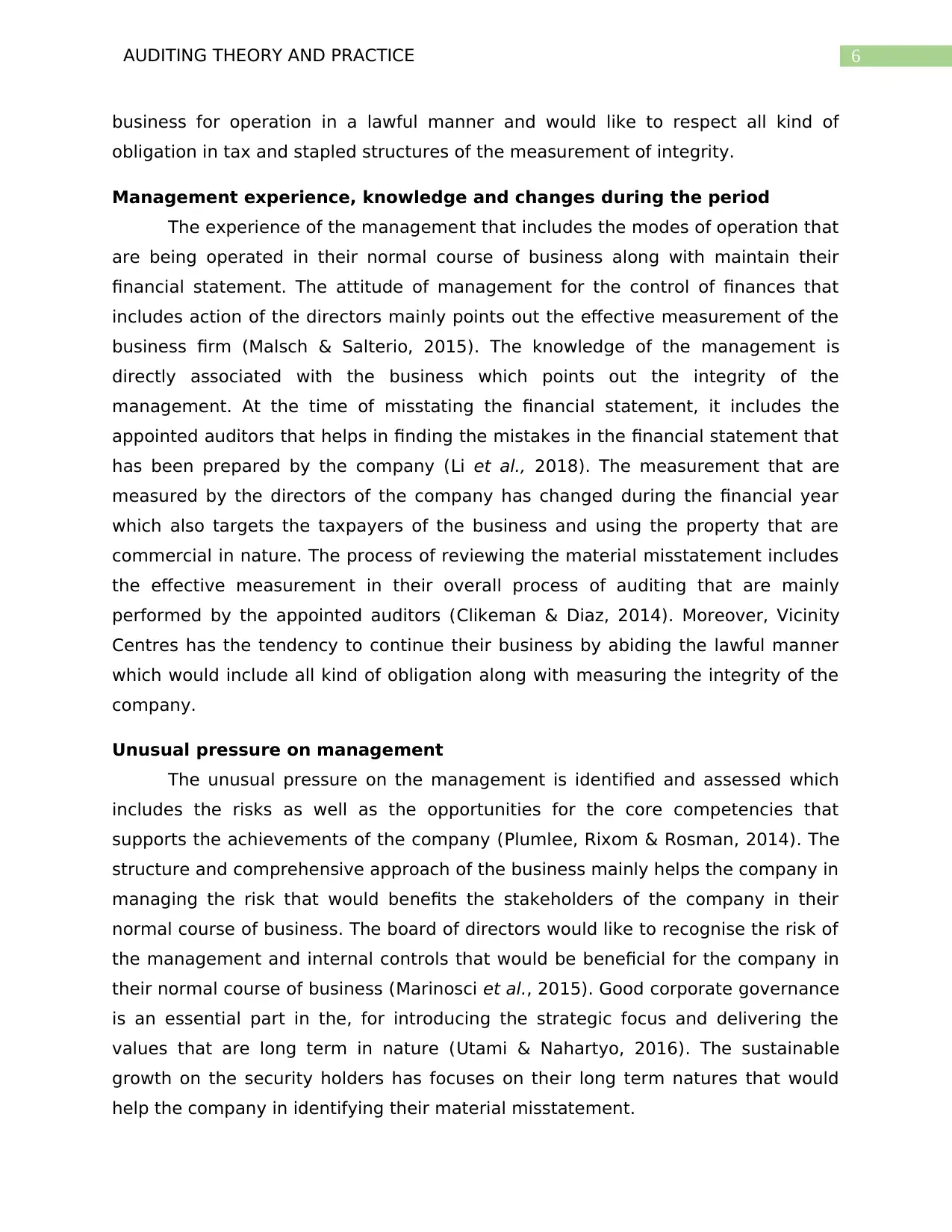
6AUDITING THEORY AND PRACTICE
business for operation in a lawful manner and would like to respect all kind of
obligation in tax and stapled structures of the measurement of integrity.
Management experience, knowledge and changes during the period
The experience of the management that includes the modes of operation that
are being operated in their normal course of business along with maintain their
financial statement. The attitude of management for the control of finances that
includes action of the directors mainly points out the effective measurement of the
business firm (Malsch & Salterio, 2015). The knowledge of the management is
directly associated with the business which points out the integrity of the
management. At the time of misstating the financial statement, it includes the
appointed auditors that helps in finding the mistakes in the financial statement that
has been prepared by the company (Li et al., 2018). The measurement that are
measured by the directors of the company has changed during the financial year
which also targets the taxpayers of the business and using the property that are
commercial in nature. The process of reviewing the material misstatement includes
the effective measurement in their overall process of auditing that are mainly
performed by the appointed auditors (Clikeman & Diaz, 2014). Moreover, Vicinity
Centres has the tendency to continue their business by abiding the lawful manner
which would include all kind of obligation along with measuring the integrity of the
company.
Unusual pressure on management
The unusual pressure on the management is identified and assessed which
includes the risks as well as the opportunities for the core competencies that
supports the achievements of the company (Plumlee, Rixom & Rosman, 2014). The
structure and comprehensive approach of the business mainly helps the company in
managing the risk that would benefits the stakeholders of the company in their
normal course of business. The board of directors would like to recognise the risk of
the management and internal controls that would be beneficial for the company in
their normal course of business (Marinosci et al., 2015). Good corporate governance
is an essential part in the, for introducing the strategic focus and delivering the
values that are long term in nature (Utami & Nahartyo, 2016). The sustainable
growth on the security holders has focuses on their long term natures that would
help the company in identifying their material misstatement.
business for operation in a lawful manner and would like to respect all kind of
obligation in tax and stapled structures of the measurement of integrity.
Management experience, knowledge and changes during the period
The experience of the management that includes the modes of operation that
are being operated in their normal course of business along with maintain their
financial statement. The attitude of management for the control of finances that
includes action of the directors mainly points out the effective measurement of the
business firm (Malsch & Salterio, 2015). The knowledge of the management is
directly associated with the business which points out the integrity of the
management. At the time of misstating the financial statement, it includes the
appointed auditors that helps in finding the mistakes in the financial statement that
has been prepared by the company (Li et al., 2018). The measurement that are
measured by the directors of the company has changed during the financial year
which also targets the taxpayers of the business and using the property that are
commercial in nature. The process of reviewing the material misstatement includes
the effective measurement in their overall process of auditing that are mainly
performed by the appointed auditors (Clikeman & Diaz, 2014). Moreover, Vicinity
Centres has the tendency to continue their business by abiding the lawful manner
which would include all kind of obligation along with measuring the integrity of the
company.
Unusual pressure on management
The unusual pressure on the management is identified and assessed which
includes the risks as well as the opportunities for the core competencies that
supports the achievements of the company (Plumlee, Rixom & Rosman, 2014). The
structure and comprehensive approach of the business mainly helps the company in
managing the risk that would benefits the stakeholders of the company in their
normal course of business. The board of directors would like to recognise the risk of
the management and internal controls that would be beneficial for the company in
their normal course of business (Marinosci et al., 2015). Good corporate governance
is an essential part in the, for introducing the strategic focus and delivering the
values that are long term in nature (Utami & Nahartyo, 2016). The sustainable
growth on the security holders has focuses on their long term natures that would
help the company in identifying their material misstatement.
Paraphrase This Document
Need a fresh take? Get an instant paraphrase of this document with our AI Paraphraser

7AUDITING THEORY AND PRACTICE
Nature of entity’s business
The nature of the business that is Vicinity Centres mainly trades with real
estate in the Australia. It is considered as one of the largest Australian multinational
company that deals with businesses of real estate which includes retail property as
well as corporate property in their overall course of business (Abuaddous, Hanefah
& Laili, 2015). The headquarter of the company is located in Melbourne in Australia
and other registered offices in Sydney, Perth, Adelaide and Brisbane. The company
is listed in the Australian stock exchange which is mainly controlled by the centres
of trust. The financial year 2015, the company has moved their head office to
Chadstone shopping centre which is considered as the largest shopping centre in
the southern hemisphere (Zuca, 2015). The corporate office of the company has
been shifted to Sydney which includes few executive of the business that works for
the company (Vicinity.com.au, 2019). The overall nature of the business is to
provide real estates that might be retail or corporate sectors to the customers.
Factors affecting the industry in which the entity operates
The real estate industry mainly operates in Australia that points out the
business which consist of sustainable development in their overall business
activities. As half of the population owns their houses in Australia that makes the
industry more attractive and potential to the customers (Moolman, 2017). The size
of the real estate market consist of many investors that attracts most of the
customers towards their business. There are some factors that affects the industry
of real industry which are as follows.
Demographics – The data of the demographics mainly points out the
demographics on the composition of the gender, age, race and other aspects. It is
significant for the factors that affects the real estates with the prices and the types
of properties that are in demand by the customers (Abuaddous, Hanefah & Laili,
2015). The tendency to affect the real estate sectors for demanding the trends of
the consumers.
Rate of interest – The health of the company mainly points out the value of
the real estate which is measured with economic indicators like GDP, data of
employment and other factors that deals with relationship with other factors.
Nature of entity’s business
The nature of the business that is Vicinity Centres mainly trades with real
estate in the Australia. It is considered as one of the largest Australian multinational
company that deals with businesses of real estate which includes retail property as
well as corporate property in their overall course of business (Abuaddous, Hanefah
& Laili, 2015). The headquarter of the company is located in Melbourne in Australia
and other registered offices in Sydney, Perth, Adelaide and Brisbane. The company
is listed in the Australian stock exchange which is mainly controlled by the centres
of trust. The financial year 2015, the company has moved their head office to
Chadstone shopping centre which is considered as the largest shopping centre in
the southern hemisphere (Zuca, 2015). The corporate office of the company has
been shifted to Sydney which includes few executive of the business that works for
the company (Vicinity.com.au, 2019). The overall nature of the business is to
provide real estates that might be retail or corporate sectors to the customers.
Factors affecting the industry in which the entity operates
The real estate industry mainly operates in Australia that points out the
business which consist of sustainable development in their overall business
activities. As half of the population owns their houses in Australia that makes the
industry more attractive and potential to the customers (Moolman, 2017). The size
of the real estate market consist of many investors that attracts most of the
customers towards their business. There are some factors that affects the industry
of real industry which are as follows.
Demographics – The data of the demographics mainly points out the
demographics on the composition of the gender, age, race and other aspects. It is
significant for the factors that affects the real estates with the prices and the types
of properties that are in demand by the customers (Abuaddous, Hanefah & Laili,
2015). The tendency to affect the real estate sectors for demanding the trends of
the consumers.
Rate of interest – The health of the company mainly points out the value of
the real estate which is measured with economic indicators like GDP, data of
employment and other factors that deals with relationship with other factors.
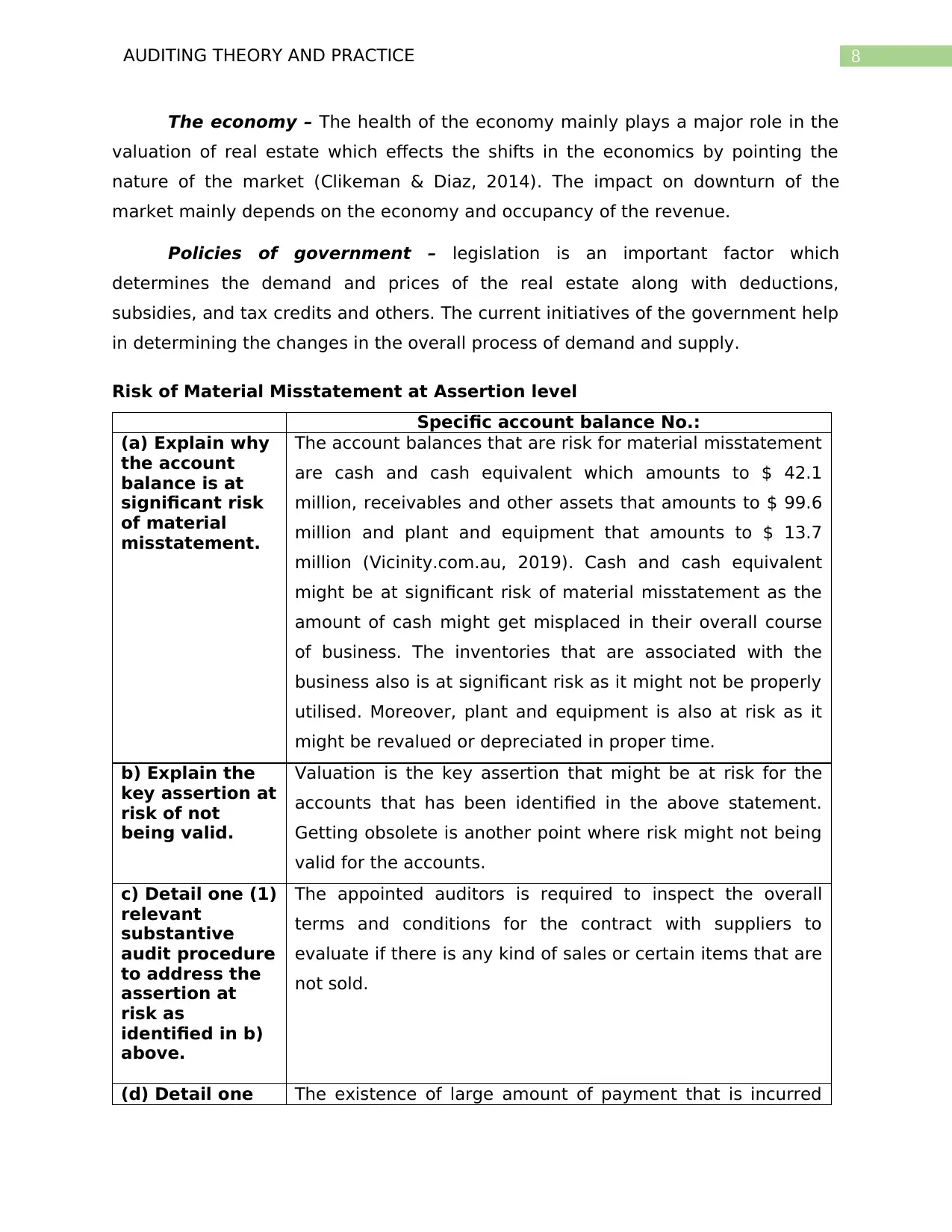
8AUDITING THEORY AND PRACTICE
The economy – The health of the economy mainly plays a major role in the
valuation of real estate which effects the shifts in the economics by pointing the
nature of the market (Clikeman & Diaz, 2014). The impact on downturn of the
market mainly depends on the economy and occupancy of the revenue.
Policies of government – legislation is an important factor which
determines the demand and prices of the real estate along with deductions,
subsidies, and tax credits and others. The current initiatives of the government help
in determining the changes in the overall process of demand and supply.
Risk of Material Misstatement at Assertion level
Specific account balance No.:
(a) Explain why
the account
balance is at
significant risk
of material
misstatement.
The account balances that are risk for material misstatement
are cash and cash equivalent which amounts to $ 42.1
million, receivables and other assets that amounts to $ 99.6
million and plant and equipment that amounts to $ 13.7
million (Vicinity.com.au, 2019). Cash and cash equivalent
might be at significant risk of material misstatement as the
amount of cash might get misplaced in their overall course
of business. The inventories that are associated with the
business also is at significant risk as it might not be properly
utilised. Moreover, plant and equipment is also at risk as it
might be revalued or depreciated in proper time.
b) Explain the
key assertion at
risk of not
being valid.
Valuation is the key assertion that might be at risk for the
accounts that has been identified in the above statement.
Getting obsolete is another point where risk might not being
valid for the accounts.
c) Detail one (1)
relevant
substantive
audit procedure
to address the
assertion at
risk as
identified in b)
above.
The appointed auditors is required to inspect the overall
terms and conditions for the contract with suppliers to
evaluate if there is any kind of sales or certain items that are
not sold.
(d) Detail one The existence of large amount of payment that is incurred
The economy – The health of the economy mainly plays a major role in the
valuation of real estate which effects the shifts in the economics by pointing the
nature of the market (Clikeman & Diaz, 2014). The impact on downturn of the
market mainly depends on the economy and occupancy of the revenue.
Policies of government – legislation is an important factor which
determines the demand and prices of the real estate along with deductions,
subsidies, and tax credits and others. The current initiatives of the government help
in determining the changes in the overall process of demand and supply.
Risk of Material Misstatement at Assertion level
Specific account balance No.:
(a) Explain why
the account
balance is at
significant risk
of material
misstatement.
The account balances that are risk for material misstatement
are cash and cash equivalent which amounts to $ 42.1
million, receivables and other assets that amounts to $ 99.6
million and plant and equipment that amounts to $ 13.7
million (Vicinity.com.au, 2019). Cash and cash equivalent
might be at significant risk of material misstatement as the
amount of cash might get misplaced in their overall course
of business. The inventories that are associated with the
business also is at significant risk as it might not be properly
utilised. Moreover, plant and equipment is also at risk as it
might be revalued or depreciated in proper time.
b) Explain the
key assertion at
risk of not
being valid.
Valuation is the key assertion that might be at risk for the
accounts that has been identified in the above statement.
Getting obsolete is another point where risk might not being
valid for the accounts.
c) Detail one (1)
relevant
substantive
audit procedure
to address the
assertion at
risk as
identified in b)
above.
The appointed auditors is required to inspect the overall
terms and conditions for the contract with suppliers to
evaluate if there is any kind of sales or certain items that are
not sold.
(d) Detail one The existence of large amount of payment that is incurred
⊘ This is a preview!⊘
Do you want full access?
Subscribe today to unlock all pages.

Trusted by 1+ million students worldwide
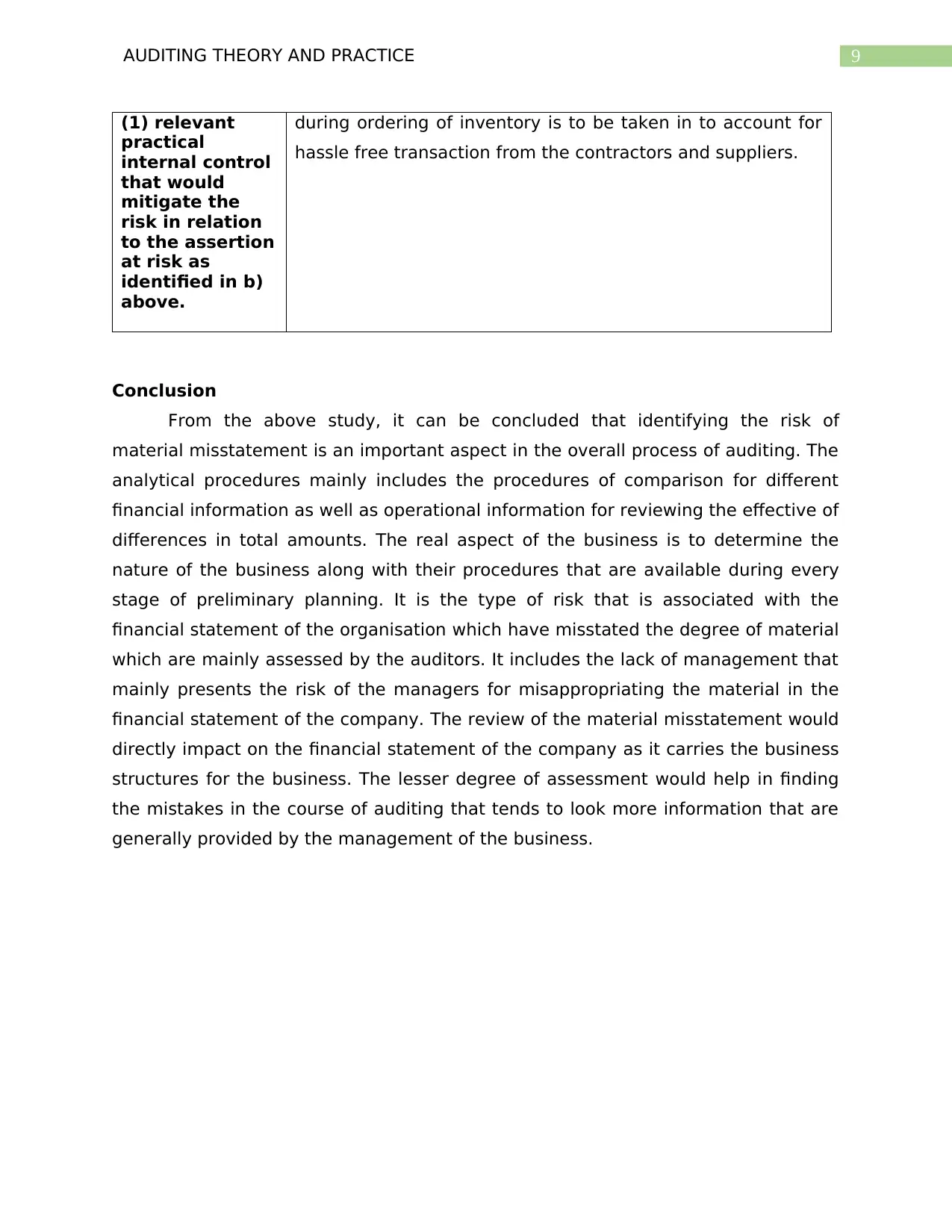
9AUDITING THEORY AND PRACTICE
(1) relevant
practical
internal control
that would
mitigate the
risk in relation
to the assertion
at risk as
identified in b)
above.
during ordering of inventory is to be taken in to account for
hassle free transaction from the contractors and suppliers.
Conclusion
From the above study, it can be concluded that identifying the risk of
material misstatement is an important aspect in the overall process of auditing. The
analytical procedures mainly includes the procedures of comparison for different
financial information as well as operational information for reviewing the effective of
differences in total amounts. The real aspect of the business is to determine the
nature of the business along with their procedures that are available during every
stage of preliminary planning. It is the type of risk that is associated with the
financial statement of the organisation which have misstated the degree of material
which are mainly assessed by the auditors. It includes the lack of management that
mainly presents the risk of the managers for misappropriating the material in the
financial statement of the company. The review of the material misstatement would
directly impact on the financial statement of the company as it carries the business
structures for the business. The lesser degree of assessment would help in finding
the mistakes in the course of auditing that tends to look more information that are
generally provided by the management of the business.
(1) relevant
practical
internal control
that would
mitigate the
risk in relation
to the assertion
at risk as
identified in b)
above.
during ordering of inventory is to be taken in to account for
hassle free transaction from the contractors and suppliers.
Conclusion
From the above study, it can be concluded that identifying the risk of
material misstatement is an important aspect in the overall process of auditing. The
analytical procedures mainly includes the procedures of comparison for different
financial information as well as operational information for reviewing the effective of
differences in total amounts. The real aspect of the business is to determine the
nature of the business along with their procedures that are available during every
stage of preliminary planning. It is the type of risk that is associated with the
financial statement of the organisation which have misstated the degree of material
which are mainly assessed by the auditors. It includes the lack of management that
mainly presents the risk of the managers for misappropriating the material in the
financial statement of the company. The review of the material misstatement would
directly impact on the financial statement of the company as it carries the business
structures for the business. The lesser degree of assessment would help in finding
the mistakes in the course of auditing that tends to look more information that are
generally provided by the management of the business.
Paraphrase This Document
Need a fresh take? Get an instant paraphrase of this document with our AI Paraphraser

10AUDITING THEORY AND PRACTICE
References
Abidin, S., & Baabbad, M. A. (2015). The use of analytical procedures by Yemeni
auditors. Corporate Ownership & Control, 12(2), 17-25.
Abuaddous, M., Hanefah, M., & Laili, N. H. (2015). Audit structure, time pressure and
judgment accuracy: A comparison between strategic system audit and
traditional audit. International Journal of Economics and Finance, 7(8), 53.
Appelbaum, D. A., Kogan, A., & Vasarhelyi, M. A. (2018). Analytical procedures in
external auditing: A comprehensive literature survey and framework for
external audit analytics. Journal of Accounting Literature, 40, 83-101.
Appelbaum, D., Kogan, A., & Vasarhelyi, M. A. (2017). Big Data and analytics in the
modern audit engagement: Research needs. Auditing: A Journal of Practice &
Theory, 36(4), 1-27.
Clikeman, P. M., & Diaz, J. (2014). ABC Electronics: An instructional case illustrating
auditors' use of preliminary analytical procedures. Current Issues in
Auditing, 8(1), I1-I10.
Dai, J., & Vasarhelyi, M. A. (2016). Imagineering Audit 4.0. Journal of Emerging
Technologies in Accounting, 13(1), 1-15.
Glover, S. M., Prawitt, D. F., & Drake, M. S. (2014). Between a rock and a hard place:
A path forward for using substantive analytical procedures in auditing large
P&L accounts: Commentary and analysis. Auditing: A Journal of Practice &
Theory, 34(3), 161-179.
Hooda, N., Bawa, S., & Rana, P. S. (2018). Fraudulent Firm Classification: A Case
Study of an External Audit. Applied Artificial Intelligence, 32(1), 48-64.
References
Abidin, S., & Baabbad, M. A. (2015). The use of analytical procedures by Yemeni
auditors. Corporate Ownership & Control, 12(2), 17-25.
Abuaddous, M., Hanefah, M., & Laili, N. H. (2015). Audit structure, time pressure and
judgment accuracy: A comparison between strategic system audit and
traditional audit. International Journal of Economics and Finance, 7(8), 53.
Appelbaum, D. A., Kogan, A., & Vasarhelyi, M. A. (2018). Analytical procedures in
external auditing: A comprehensive literature survey and framework for
external audit analytics. Journal of Accounting Literature, 40, 83-101.
Appelbaum, D., Kogan, A., & Vasarhelyi, M. A. (2017). Big Data and analytics in the
modern audit engagement: Research needs. Auditing: A Journal of Practice &
Theory, 36(4), 1-27.
Clikeman, P. M., & Diaz, J. (2014). ABC Electronics: An instructional case illustrating
auditors' use of preliminary analytical procedures. Current Issues in
Auditing, 8(1), I1-I10.
Dai, J., & Vasarhelyi, M. A. (2016). Imagineering Audit 4.0. Journal of Emerging
Technologies in Accounting, 13(1), 1-15.
Glover, S. M., Prawitt, D. F., & Drake, M. S. (2014). Between a rock and a hard place:
A path forward for using substantive analytical procedures in auditing large
P&L accounts: Commentary and analysis. Auditing: A Journal of Practice &
Theory, 34(3), 161-179.
Hooda, N., Bawa, S., & Rana, P. S. (2018). Fraudulent Firm Classification: A Case
Study of an External Audit. Applied Artificial Intelligence, 32(1), 48-64.
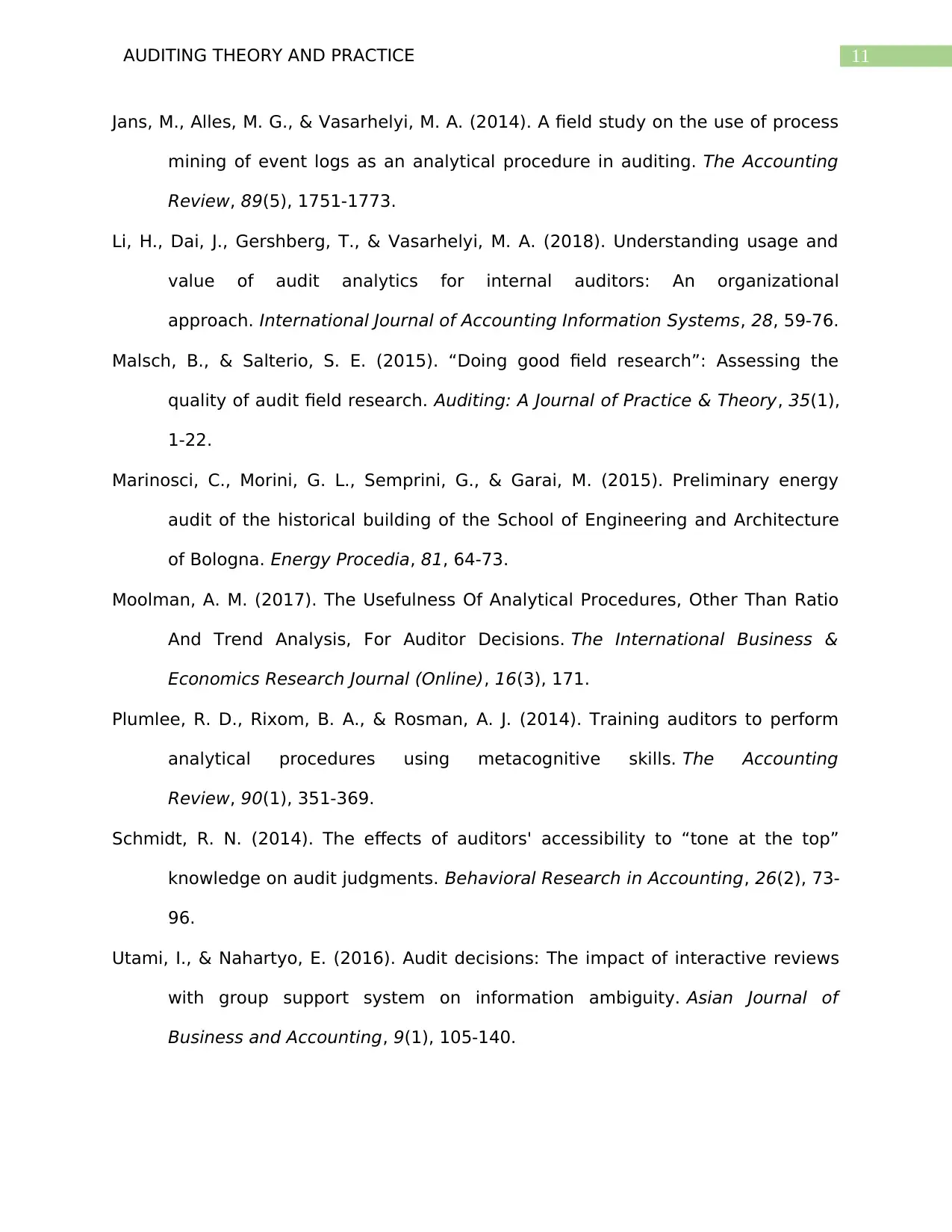
11AUDITING THEORY AND PRACTICE
Jans, M., Alles, M. G., & Vasarhelyi, M. A. (2014). A field study on the use of process
mining of event logs as an analytical procedure in auditing. The Accounting
Review, 89(5), 1751-1773.
Li, H., Dai, J., Gershberg, T., & Vasarhelyi, M. A. (2018). Understanding usage and
value of audit analytics for internal auditors: An organizational
approach. International Journal of Accounting Information Systems, 28, 59-76.
Malsch, B., & Salterio, S. E. (2015). “Doing good field research”: Assessing the
quality of audit field research. Auditing: A Journal of Practice & Theory, 35(1),
1-22.
Marinosci, C., Morini, G. L., Semprini, G., & Garai, M. (2015). Preliminary energy
audit of the historical building of the School of Engineering and Architecture
of Bologna. Energy Procedia, 81, 64-73.
Moolman, A. M. (2017). The Usefulness Of Analytical Procedures, Other Than Ratio
And Trend Analysis, For Auditor Decisions. The International Business &
Economics Research Journal (Online), 16(3), 171.
Plumlee, R. D., Rixom, B. A., & Rosman, A. J. (2014). Training auditors to perform
analytical procedures using metacognitive skills. The Accounting
Review, 90(1), 351-369.
Schmidt, R. N. (2014). The effects of auditors' accessibility to “tone at the top”
knowledge on audit judgments. Behavioral Research in Accounting, 26(2), 73-
96.
Utami, I., & Nahartyo, E. (2016). Audit decisions: The impact of interactive reviews
with group support system on information ambiguity. Asian Journal of
Business and Accounting, 9(1), 105-140.
Jans, M., Alles, M. G., & Vasarhelyi, M. A. (2014). A field study on the use of process
mining of event logs as an analytical procedure in auditing. The Accounting
Review, 89(5), 1751-1773.
Li, H., Dai, J., Gershberg, T., & Vasarhelyi, M. A. (2018). Understanding usage and
value of audit analytics for internal auditors: An organizational
approach. International Journal of Accounting Information Systems, 28, 59-76.
Malsch, B., & Salterio, S. E. (2015). “Doing good field research”: Assessing the
quality of audit field research. Auditing: A Journal of Practice & Theory, 35(1),
1-22.
Marinosci, C., Morini, G. L., Semprini, G., & Garai, M. (2015). Preliminary energy
audit of the historical building of the School of Engineering and Architecture
of Bologna. Energy Procedia, 81, 64-73.
Moolman, A. M. (2017). The Usefulness Of Analytical Procedures, Other Than Ratio
And Trend Analysis, For Auditor Decisions. The International Business &
Economics Research Journal (Online), 16(3), 171.
Plumlee, R. D., Rixom, B. A., & Rosman, A. J. (2014). Training auditors to perform
analytical procedures using metacognitive skills. The Accounting
Review, 90(1), 351-369.
Schmidt, R. N. (2014). The effects of auditors' accessibility to “tone at the top”
knowledge on audit judgments. Behavioral Research in Accounting, 26(2), 73-
96.
Utami, I., & Nahartyo, E. (2016). Audit decisions: The impact of interactive reviews
with group support system on information ambiguity. Asian Journal of
Business and Accounting, 9(1), 105-140.
⊘ This is a preview!⊘
Do you want full access?
Subscribe today to unlock all pages.

Trusted by 1+ million students worldwide

12AUDITING THEORY AND PRACTICE
Utami, I., Kusuma, I., Gudono, D., & Supriyadi, D. (2014). Halo effect in analytical
procedure: the impact of client profile and information scope. Global Journal
of Business Research, 8(1), 9-26.
van Buuren, J., Koch, C., van Nieuw Amerongen, N., & Wright, A. M. (2014). The use
of business risk audit perspectives by non-Big 4 audit firms. Auditing: A
Journal of Practice & Theory, 33(3), 105-128.
Vicinity.com.au. (2019). Annual Report 2018. Retrieved on 8 September 2019
retrieved from: https://www.vicinity.com.au/media/763327/vicinity-annual-
report-2018.pdf
Yoon, K., Hoogduin, L., & Zhang, L. (2015). Big Data as complementary audit
evidence. Accounting Horizons, 29(2), 431-438.
Zuca, S. (2015). Audit evidence–necessity to qualify a pertinent opinion. Procedia
Economics and Finance, 20, 700-704.
Utami, I., Kusuma, I., Gudono, D., & Supriyadi, D. (2014). Halo effect in analytical
procedure: the impact of client profile and information scope. Global Journal
of Business Research, 8(1), 9-26.
van Buuren, J., Koch, C., van Nieuw Amerongen, N., & Wright, A. M. (2014). The use
of business risk audit perspectives by non-Big 4 audit firms. Auditing: A
Journal of Practice & Theory, 33(3), 105-128.
Vicinity.com.au. (2019). Annual Report 2018. Retrieved on 8 September 2019
retrieved from: https://www.vicinity.com.au/media/763327/vicinity-annual-
report-2018.pdf
Yoon, K., Hoogduin, L., & Zhang, L. (2015). Big Data as complementary audit
evidence. Accounting Horizons, 29(2), 431-438.
Zuca, S. (2015). Audit evidence–necessity to qualify a pertinent opinion. Procedia
Economics and Finance, 20, 700-704.
1 out of 13
Related Documents
Your All-in-One AI-Powered Toolkit for Academic Success.
+13062052269
info@desklib.com
Available 24*7 on WhatsApp / Email
![[object Object]](/_next/static/media/star-bottom.7253800d.svg)
Unlock your academic potential
© 2024 | Zucol Services PVT LTD | All rights reserved.



